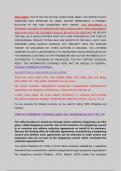DISCLAIMER: THIS IS NOT AN OFFICIAL GUIDE FROM UNISA. THE REPORT IS NOT
PREPARED NOR APPROVED BY UNISA, RATHER REPRESENTS A POSSIBLE
SOLUTION TO THE TASK CONSISTENT WITH THEORY. THIS ASSIGNMENT IS
INTENDED TO ASSIST STUDENTS IN GETTING STARTED WITH THEIR ASSIGNMENT,
AND IN NO CASE THIS DOCUMENT SHOULD BE USED FOR CHEATING. WE BELIEVE
THIS WILL BE A GOOD STARTING POINT AS IT WAS PREPARED BY OUR TEAM OF
PROFESSIONAL PRIVATE TUTORS WHO ARE EXPERTS IN THE FIELD, AND IT WAS
PREPARED USING VARIOUS SOURCES. ANY SIMILARITY WITH ANY EXISTING
THEORY OR DISCUSSION BY OTHER AUTHORS IS EXCUSED. THE AUTHORS
HOWEVER DO NOT CLAIM MONOPOLY TO KNOWLEDGE HENCE MODIFICATION OF
THE ANSWERS CONTAINED IN THIS FRAMEWORK MAY NOT BE PROHIBITED AS IT
CONTRIBUTES TO EXPANSION OF KNOWLEDGE. FOR ANY FURTHER GUIDELINE
ABOUT THE INFORMATION CONTAINED HERE AND THE MODULE IN GENERAL,
CONTACT PASSMATE TUTORIALS.
WE ASSIST WITH OTHER MODULES INCLUDING:
ECSs, FACs, MACs, MNGs, INTs, TRLs, HMEMS, PRMs, PROs, MNBs, DSC, QMI, MNMs,
MNO, MNPs, FIN, PUBs, MNMs, RESEARCH among others.
WE OFFER CLASSES, ASSIGNMENT GUIDELINES, EXAMINATION PREPARATION,
RESEARCH AND RESEARCH PROPOSALS, DISSERTATION EDITING etc.
OTHER THAN UNISA, WE ALSO ASSIST STUDENTS AT VARIOUS INSTITUTIONS
INCLUDING MANCOSA, REGENT, REGEYNESES, BOSTON, STADIO, OLG, UJ, UP etc
For any enquiries the following numbers can be used for calling, SMS, WhatsApp and
telegram
CONTACT PASSMATE TUTORIALS @061 262 1185/068 053 8213/0717 513 144
The LRA provides for structures through which collective bargaining can take
place, called bargaining councils. One of the functions of a bargaining council
is to conclude and enforce collective agreements on behalf of its members.
Discuss the binding effect of collective agreements concluded by a bargaining
council and whether such agreements can be extended to trade unions and
employers who are not part of the bargaining council which concluded the
collective agreement (10)
The Labour Relations Act (LRA) in South Africa oversees establishing a legislative
framework that is essential for collective bargaining through recognized organizations
like bargaining councils (Phalane, 2019). Maphiri (2023) states that employer
, organizations and registered trade unions create these councils to settle labour
disputes, contract mismatches, collective bargaining agreements, and other relevant
matters of shared interest that arise in various national sectors. Thus, the purpose of
this assignment is to examine the statutory binding perspective and the binding
implications of collective agreements, as well as how parties to the agreement can
extend such agreements to trade unions.
The binding effect of collective agreements
Phalane (2019) asserts that the LRA establishes the legitimacy of collective bargaining
agreements and determines whether they may be extended. Sections 23 and 32 of
the LRA serve as the starting point for this. Parties are bound by the collective
bargaining agreement, with the bargaining council playing a crucial role in this regard
by involving trade unions and employers who are members of the council (James,
2022). According to research by Mutengwe, Mazenda, and Simawu (2024),
employees who belong to trade unions are also bound by the collective agreement.
Because of the organizational involvement, employer-employee interactions are
strengthened. Le Roux (2020), who elaborated on the statutory bindingness of the
collective bargaining agreement and trade unions, likewise backed this claim. All
members of employers' organizations and trade unions are considered legal parties of
the bargaining council, according to research interpretations. This claim ignores the
parties' direct participation in the agreement's negotiation (Matumane, 2023).
Therefore, if the bargaining council has jurisdiction over the issue, Mathe (2020) states
that anybody who was an employee of the organization has a legally obligatory
obligation.
Collective agreements extension
It is important to remember that, under certain circumstances, these collective
agreements may be extended to non-parties. In the case of manufacturing, mining,
healthcare, agriculture, and food processing, for example, Ntimba (2019) emphasized
that the bargaining council needs to confirm that the collective agreement adequately
represents the interests of both the employer and the employee in the same sector
(Phalane, 2019). According to Englert and Runciman (2019), a trade union's
representation of the majority of its members' employees and a small percentage of
its employers' members constitutes an adequately representative representation.




